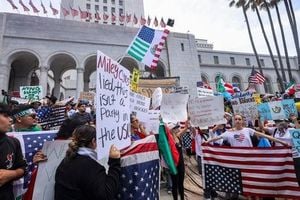Boeing’s Starliner program has been plagued by repeated delays and financial mishaps, raising concerns about the company’s ability to deliver its promised safety and reliability in commercial crew transport. As the spacecraft remains in orbit, NASA faces crucial decisions regarding the safe return of astronauts and the future of its partnership with Boeing.
The Starliner spacecraft, launched on June 5, was initially expected to complete a short mission to the International Space Station (ISS) and return by June 14. However, complications have forced NASA to reevaluate its plans. The spacecraft has been docked for over 50 days, far in excess of the original timeline, generating significant discussions about the astronauts’ eventual return.
NASA officials have expressed concerns about multiple issues with Starliner's thrusters—vital engines required for maneuvering the craft in orbit and during re-entry. During the spacecraft’s approach to the ISS, a number of thrusters failed to operate as expected, resulting in a delay in the immediate return of the crew. This incident has led to ongoing testing and investigations into the thrusters' reliability, and although most of them appear operational, the absence of a clear root cause for the failures poses a significant risk.
Amid these challenges, NASA is contemplating whether to bring the crew safety home aboard the Starliner or use SpaceX’s Crew Dragon spacecraft as a backup. The latter option would mean potentially removing astronauts from an upcoming mission to accommodate the Starliner crew, a move that raises logistical and morale concerns.
Boeing has consistently communicated confidence in Starliner’s ability to ensure a safe return for the astronauts. A spokesperson stated that the company possesses the “flight rationale” to believe the spacecraft can complete its mission without incident. Mark Nappi, vice president of the Starliner program, noted, “We remain confident in the Starliner spacecraft and its ability to return safely with crew.”
However, behind the public assurances lies a different story. Sources indicate a growing lack of confidence in Starliner’s safety within NASA, reflecting ongoing worries about how well the spacecraft can handle critical maneuvering tasks. The internal discussions among NASA officials highlight the uncertainty, and they have yet to reach a consensus.
While NASA officials had hoped that a successful return would help cement Boeing’s place in the commercial crew transport business, the mounting financial struggles associated with the Starliner program complicate matters further. To date, Boeing has recorded losses totaling $1.6 billion across its Starliner endeavors. When NASA first awarded Boeing a $4.2 billion contract in 2010, they anticipated the spacecraft would be operational by 2017. Instead, late-stage and unforeseen complications have drawn out the timeline considerably.
Boeing's leadership has cited fixed-price contracts with NASA as a contributing factor to the financial losses. In these arrangements, contractors assume the financial risks associated with cost overruns, leaving Boeing on the hook for any additional expenses linked to delays or complications. This model contrasts sharply with how SpaceX has approached its contracts, often turning a profit and successfully completing multiple manned missions to the ISS using its Crew Dragon spacecraft.
SpaceX's successful performance has positioned it as a trusted option at NASA, solidifying an alternative pathway for the astronauts. If NASA ultimately opts to use SpaceX’s Crew Dragon, it risks publically undermining Boeing’s longstanding partnership with the agency. In discussions about the ongoing situation, NASA officials highlighted the importance of “astronaut safety” as their top priority.
The decision to modify the astronauts’ return plan, such as to operate with Crew Dragon, would also send rippling effects back to Boeing’s operational strategies. Many within the agency believe a successful return with the crew aboard Starliner is crucial to Boeing's ongoing contract credibility. If Starliner successfully brings the crew home, it would still face scrutiny; should any complications arise during re-entry, it could have disastrous consequences for Boeing's credibility and future contracts.
For now, astronauts Butch Wilmore and Suni Williams, both seasoned astronauts, remain aboard the ISS, carrying out their responsibilities while NASA evaluates the best course of action. Their situation highlights the tension between space ambitions and the practical safety concerns that underpin every human spaceflight mission.
As the discussions continue, the stakes remain high for both Boeing and NASA. The choice to rely on Starliner or shift towards SpaceX’s proven capabilities will set the tone for future U.S. space ambitions, reflecting broader dynamics between government contracts and public confidence in aerospace industry performance. With no clear solutions on the horizon, the space community watches as this pivotal moment unfolds.



